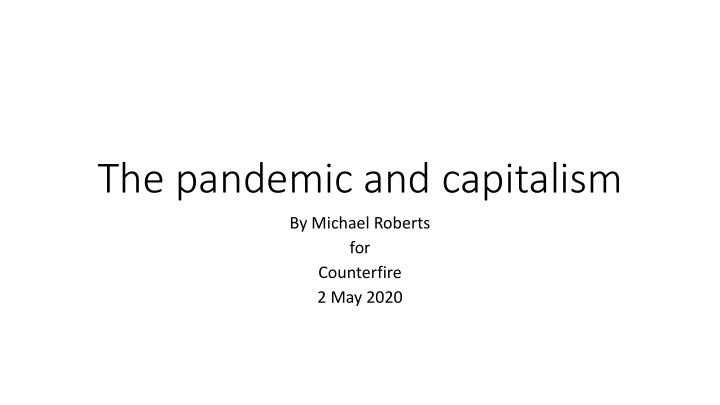



The pandemic and capitalism By Michael Roberts for Counterfire 2 May 2020
From wildlife to animals to humans
Just another flu?
50m deaths or lockdown?
Be prepared!
Flattening the curve: hospitals overloaded
Excess in London
Sweden near the top
Lockdown and slump • 2.7 bn workers worldwide are now affected by full or partial lockdown measures, representing around 81 % of the world’s 3.3 billion workforce. • The world economy has seen nothing like this. Nearly all economic forecasts for global GDP in 2020 are for a contraction of 3-5%, as bad if not worse than in the Great Recession of 2008-9 . • In lockdowns, output in most economies will fall by 25% (OECD); the lockdown will directly affect sectors amounting to up to one third of GDP in the major economies. For each month of containment, there will be a loss of 2 percentage points in annual GDP growth. • Short-term collapse in global output likely to rival or exceed any recession of the last 150 years - Kenneth Rogoff. • “We now project that over 170 countries will experience negative per capita income growth this year.” IMF chief Kristalina Georgieva
“ Every child knows a nation which ceased to work, I will not say for a year, but even for Only labour a few weeks, would perish.” creates (Marx to Kugelmann, London, value July 11, 1868).
Lost forever
Emerging economies to slump
• Of the total global working population of 3.3 billion, about 2 billion work in the “informal economy”, often on Billions to lose short-term contracts or self- employment, and suffered a 60% incomes- ILO collapse in their wages in the first month of the crisis. Of these, 1.6 billion face losing their livelihoods,
• Under the most serious scenario - a 20% contraction in income - the More than half number of people living in extreme poverty would rise by 434 million a billion back people to 922 million worldwide. The same scenario would see the number into poverty of people living below the $5.50 a day threshold rise by 548 million people to nearly 4 billion - Oxfam
Only half workers are working
Most households have lost income
Output collapse
Profitability crunch: secular stagnation
No return to normal: US economy
The UK economy will never return to its already weak pre-crisis trend On average, GDP is around 14 per cent below a continuation of its pre- recession trend (with the trend assumed to be the growth rate over the five years prior to the start of the recession
The lessons • It’s capitalism that is generating these crises, not nature as such: environmental pollution, industrial farming, climate change, pandemics – there are more pandemics to come • The market does not work - whether it be the COVID-19 crisis, the next pandemic or the climate crisis. Government has had to intervene and direct . • The COVID-19 crisis has exposed that it is those workers whose jobs are most undervalued by this system who we most rely on . • Failure of private healthcare and big pharma: we need free public healthcare; mass public investment in research and production of medicines and vaccines. • Instead of bailouts of big business, we need takeovers and planning; not looking to return to ‘normal’ • Debt cancellation for poor countries; end tax havens • Public ownership of key services: eg Amazon, mail ,broadband, social media. • A socialised economy democratically-run and internationally coordinated
Recommend
More recommend